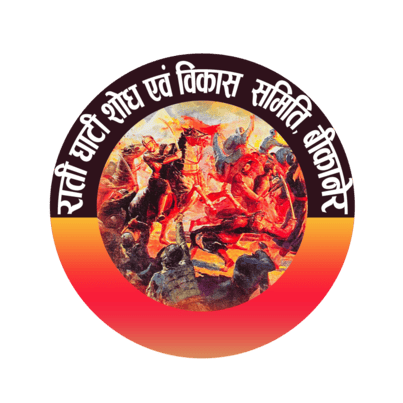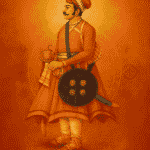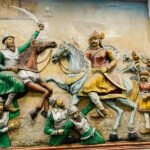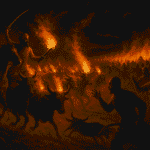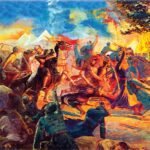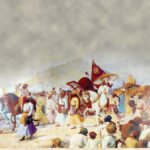Rati Ghati Yudh
(Battle of Rati Ghati : A National Victory)
Bikaner’s Rati Ghati Yudh Saturday, 26 Oct. 1534
Battle of Rati Ghati: A National Victory The victory of the Battle of Rati Ghati is a symbol of India’s national pride. This historic battle was fought on the northwestern border of India in Bikaner, on the 26th of October, 1534, corresponding to the 4th and 5th day of the dark fortnight in the month of Migsar in the Vikram Samvat year 1591. This battle took place just 45 years after the establishment of the newly-formed Bikaner state. In this battle, Rao Jaitsi, the son of Bikaner’s founder Rao Bika and the fourth ruler of Bikaner, decisively defeated Kamran, son of Mughal emperor Babur and ruler of Ghazni and Lahore. This is a golden but lesser-known chapter in the history of Indian resistance. Before narrating the battle itself, it is important to shed light on its background. Jangal Desh (Jungle Region) The region to the east of the Sindhu River was known as Sauveer during the Mahabharata era. During the establishment of the Bikaner state, this region was called Jangal Desh, with Janglu as its capital. The ruler of Jangal Desh, Napa Ji Sankhla, had two sisters, one married to Rao Jodha of Jodhpur and the other to Maharana Kumbha of Mewar. However, due to continuous Muslim invasions, Napa Ji grew weak and sought the help of his nephew Bika to establish the kingdom of Bikaner. Rao Bika secured India’s western borders and established a strong Rathore kingdom. His son, Rao Lunkaran, extended the kingdom up to Hisar, but he was martyred in the Battle of Dhousi near Narnaul. After his death, his son Rao Jaitsi became the ruler of Bikaner and the hero of the Battle of Rati Ghati. Rao Jaitsi : A Great Warrior and Strategist Rao Jaitsi had fought in several battles alongside his father and was known for his excellent military skills and strategy. He was a benevolent ruler and kept a keen eye on national affairs. His reign is considered a golden era in Bikaner’s history. Despite facing severe droughts in the desert region, he focused on environmental conservation and the construction of water sources. Although the state of Bikaner was secure, it faced a looming threat from Babur’s Mughal empire, whose territories had expanded up to Bikaner’s borders after Babur’s conquest of the Sindh province. Babur’s victory over Ibrahim Lodi in 1526 made him the ruler of Delhi, and this posed a direct threat to Bikaner. The Battle of Khanwa and its Aftermath The Battle of Khanwa in 1527 between Rana Sanga and Babur played a crucial role in the events leading to the Battle of Rati Ghati. In this battle, Rao Jaitsi sent his son Kalyanmal with 3,000 horsemen to fight on Rana Sanga’s side. They were positioned on the left flank of Sanga’s army and were instrumental in controlling Babur’s artillery. This angered Babur, and he assigned his sons the task of punishing Rao Jaitsi. At that time, foreign invaders had penetrated India’s heartland through the northwestern borders. In response, many brave warriors sacrificed everything to stop them. However, in four major battles-Tarain (between Prithviraj Chauhan and Muhammad Ghori), Talikota, Khanwa, and Haldighati-although Indian forces fought valiantly, they did not achieve decisive victories. The Rati Ghati Battle : A Fierce Struggle On the 26th of October 1534, Kamran, with 25,000 well-trained soldiers, a powerful artillery, and 1,000 elite officers, set out from Lahore and attacked Bhatner. Kamran’s assault was so fierce that the poet Bithu Suja wrote that the fort of Bhatner was destroyed like a bird’s nest struck by lightning. Khetsi Kandhlot, along with 1,000 warriors, performed Saka and Johar (ritual suicide). After conquering Bhatner, Kamran besieged Rao Jaitsi’s fort of Sobhaag Deep (today’s Shri Laxminathji Temple Complex) at Bikaner, where the fort commander Bhojraj Ji Roopavat and 2,500 warriors resisted for an entire day. However, by nightfall, Kamran had entered the fort and began celebrating his victory. Rao Jaitsi’s Nighttime Victory For the first time, the Rajputs adopted guerrilla warfare tactics. Before Kamran’s forces could enter Bikaner, Rao Jaitsi evacuated the entire city. Kamran found an empty Bikaner and no sign of the enemy. Meanwhile, Rao Jaitsi, with his main army, had retreated to a hidden location and began preparing for a counter-attack. He divided his army into 108 units, with 54 Rathore leaders, and warriors from Marwar, Jhabua (Madhya Pradesh), Idar (now Himatnagar, Gujarat), and several other regions of Rajputana. Leaders from different castes, including Brahmins, Rajpurohits, Maheshwaris, Oswals, and even Muslim commanders, joined the battle. Despite being numerically smaller, Jaitsi’s forces included many experienced warriors from the Battle of Khanwa. His war cry was “Ram Ram,” as a response to Babur’s desecration of Ram temples. A New Strategy: The Counter-Wheel Formation Rao Jaitsi used a new strategy and formed a counter-wheel formation in the Luni Valley. In a surprise nighttime attack, he sent young warriors aged 13 to 17, led by Jaymal (later known as a hero in the Siege of Chittorgarh) and his son Kant, to infiltrate Kamran’s army. This unexpected assault stunned Kamran’s troops, but they quickly regrouped. A fierce battle ensued. Rao Jaitsi’s forces broke through the Mughal lines and reached Kamran’s camp, where the Mughal commander Aftab gave his life to save Kamran. Following Alam Chal Beg’s advice, Kamran fled the battlefield but not before destroying the Chintamani Parshwanath Temple with cannons, declaring that this demolished temple would stand as a witness to his invasion of Bikaner. Psychological Warfare Rao Jaitsi also employed psychological warfare. As he launched his attack, he ordered villagers to tie torches to the horns of their oxen, creating the illusion of a massive approaching army. Those with camels tied three torches to each camel and attached drums to their saddles, creating an overwhelming spectacle. The Mughal forces were demoralized and fled, thinking they were surrounded by countless enemies. Aftermath and Legacy With this decisive victory, Rao Jaitsi returned to Sobhaag Deep Fort, freeing the captive women and cattle. Celebrations were held throughout the kingdom for several days. However, despite the significance of the Battle of Rati Ghati, it did not gain its rightful place in history. Poet Bithu Suja composed a 401-verse epic in Dingal on the battle, but it wasn’t until 1919, when Dr. L.P. Tessitori translated the work, that the battle gained scholarly attention. In 1990-91, the Rati Ghati Research and Development Committee began extensive research, and today, the battle has gained national recognition. It has been included in the Rajasthan school curriculum since 2012 and 2017 for 9th and 10th graders, respectively. The Battle of Rati Ghati remains a symbol of India’s indomitable spirit, courage, and national pride
Rati Ghati Shodh & Vikas Samiti (Akhil Bhartiya Itihas Sanklan Samiti, New Delhi) Brahmpuri Chowk, Bikaner (Raj.) M. 8107235878
